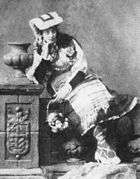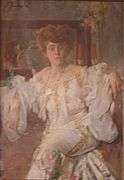Gabriela Zapolska
| Gabriela Zapolska | |
|---|---|
|
| |
| Born |
30 March 1857 Pidhaitsi (Podhajce) near Lutsk, Austria-Hungary |
| Died |
21 December 1921 (aged 64) Lwów, Poland |
| Pen name | Gabriela Zapolska, Józef Maskoff, Walery Tomicki, Maryja, Marya, Omega, Szczerba |
| Occupation | Novelist, publicist, playwright, prosaist |
| Nationality | Polish |
| Literary movement | Naturalism |
| Spouse |
Konstanty Śnieżko-Błocki (divorced) Stanisław Janowski (divorced) |
Maria Gabriela Stefania Korwin-Piotrowska (1857–1921), known as Gabriela Zapolska, was a Polish novelist, playwright, naturalist writer, feuilletonist, theatre critic and stage actress. Zapolska wrote 41 plays, 23 novels, 177 short stories, 252 works of journalism, one film script, and over 1,500 letters.[1]
Zapolska received most recognition for her socio-satirical comedies. Among them, Moralność pani Dulskiej (The Morality of Mrs. Dulska) – a tragic-farce about petty-bourgeois – is considered the most famous internationally. It is regarded as a landmark of early modernist Polish drama.[2] Her stage plays were translated into foreign languages, and performed at Polish and European theatres, as well as adapted for radio and film. Zapolska herself acted on stage in over 200 plays in Warsaw, Kraków, Poznań, Lwów, Saint Petersburg and Paris.[1]
Life
Zapolska was born on 30 March 1857 in Podhajce, to a family of Polish gentry; on the territory ruled by Austria-Hungary after the Third and final Partition of Poland, (now Pidhaitsi, Ukraine). Her father was a marshal of Volhynian szlachta. Zapolska studied at the Sacré Coeur Institute and in the Institute of Education and Science in Lwów. In 1876 she was forced by her family to marry a Polish lieutenant in the Tsarist guard, Konstanty Śnieżko-Błocki, but soon left him and divorced in 1888. During the years of 1879–1880 she lived in Warsaw, where she acted in an amateur theatre ran by the Philanthropy Society. In 1881 Zapolska became pregnant by an out-of-wedlock relationship and left her family.[3] The same year she made her own short story debut by Jeden dzień z życia róży (One Day in the Life of a Rose). The following year, in 1882, she became a professional actress in the Kraków theatre, and assumed the pseudonym of Gabriela Zapolska. She also acted in Poznań, and in travelling troupes throughout the Congress Poland. In October 1888 she reportedly made a suicide attempt.[4]
In 1889 Zapolska moved to Paris in hope to make an artistic career. There, she played minor roles in boulevard theatres, Théâtre Libre and Théâtre de l'Œuvre. She played in a stage adaptation of Intérieur (Interior) by Maurice Maeterlinck in Théâtre de l'Oeuvre. In Paris, Zapolska established contacts within the artistic milieu as well as with Polish socialist emigrants, which influenced her social views.[3]
After coming back to her country, she settled in Kraków and acted in garden theatres, travelling troupes, and then in Kraków Juliusz Słowacki Theatre directed by Tadeusz Pawlikowski. Her defiant, suffragist nature led to conflicts with theatre principals. Following Pawlikowski's departure, in 1900 she abandoned her contract. After that, Zapolska set up her own stage which was active time-by-time. In 1902 Zapolska ran a drama school in Kraków and the Gabriela Zapolska Independent Theatre was founded later. Her experiences in Paris let her to produce two Maeterlinck stage adaptations – Princess Maleine, and L'Intruse (The Intruder), both produced in 1902.
In 1904 she moved to Lwów and married a painter, Stanisław Janowski. She became a patron of the travelling theatre named after her (Gabriela Zapolska Theatre) which during the years of 1907–1908 toured Galicia. She divorced her second husband in 1910.[4] In the years of 1912–1913 Zapolska was a literary director of Teatr Premier. As a feuilletonist and theatre critic she collaborated with Gazeta Krakowska, Słowo Polskie, Nowa Reforma, Ilustracja Polska and Wiek Nowy. In 1915, after Lwów was captured by the Russian Army, she ran a small confectionery. Zapolska died on 17 December 1921 in Lwów (now Lviv, Ukraine) and buried at the Lychakivskiy Cemetery there.
Style and themes
Gabriela Zapolska's works were dominated by naturalism – a literary movement seeking to replicate everyday reality. She was mainly influenced by Émile Zola, a French naturalist writer. Her output has a journalistic and didactic tone. She portrayed the lives of the poorest and most vulnerable people including proletarians, Jews, servants, prostitutes, etc.
Characters in Zapolska's works are mostly of ordinary type. She tends to skip psychological analysis as it was specific for the Young Poland writers.[3] She also brought up controversial subjects, such as prostitution and venereal disease (O czym się mówi, O czym się nawet myśleć nie chce).
Zapolska created acrimonious and embittered literary characters, such as those in her best-known works, Moralność pani Dulskiej, Żabusia, Ich czworo. Tragedia ludzi głupich, Sezonowa miłość, and Panna Maliczewska.[3]
Prose
| Library resources about Gabriela Zapolska |
| By Gabriela Zapolska |
|---|
Gabriela Zapolska made her own short story debut in 1881 by Jeden dzień z życia róży. Many of her early works was published in parts in Lwów and then, in Warsaw press, mainly in Przegląd Tygodniowy. She collected her early short stories in the volume of Z dziejów boleści (1890). Her novels and short stories were translated into many languages, including English, Russian, German, Swedish, Czech, Slovak, Hungarian, Ukrainian. Zapolska was criticized by conservatives for the more naturalist aspects of her works, such as perceived immorality, squalor, taboo subjects, etc.[3] Notable Zapolska prose works include:
- Jeden dzień z życia róży (One Day in the Life of a Rose, 1881)
- Małaszka (1883)
- Kaśka Kariatyda (Cathy the Caryatid, 1885–1886)
- Przedpiekle (1889)
- Menażeria ludzka (1893)
- Janka (1895)
- Fin-de-sièclistka (Fin-de-siècle-ist, 1897)
- Zaszumi las (1899)
- Sezonowa miłość (1904)
- Córka Tuśki (1907)
- Pani Dulska przed sądem (1908)
- O czym się nie mówi (1909)
- Śmierć Felicjana Dulskiego (Death of Felicjan Dulski, 1911)
- Kobieta bez skazy (1913)
- O czym się nawet myśleć nie chce (1914)
Dramas
Zapolska is best known for her dramas, socio-satirical comedies and tragicomedy works.[3] Her Moralność pani Dulskiej, a 'petty-bourgeois tragic-farce', is considered by her most-known work and regarded as a landmark of early modernist Polish drama.[2] The story of Moralność pani Dulskiej was continued in two short stories—Pani Dulska przed sądem and Śmierć Felicjana Dulskiego. Her dramas were translated into other languages, played at the Polish and European stages, and adapted into radio and film. Notable Zapolska dramas include:
- Żabusia (Froggie, 1897)
- Małka Szwarcenkopf (1897)
- Jojne Firułkes (1898)
- Moralność pani Dulskiej (The Morality of Mrs. Dulska, 1906)
- Ich czworo. Tragedia ludzi głupich (1907)
- Skiz (1908)
- Panna Maliczewska (Miss Maliczewska, 1910)
Film adaptations
Movies based on Zapolska novels or dramas include:
- Carewicz (1918) – directed by Marian Fuks
- Tamten (1921) – by Władysław Lenczewski
- O czym się nie mówi (1924) – by Edward Puchalski
- Policmajster Tagiejew (1929) – by Juliusz Gardan
- Moralność pani Dulskiej (1930) – by Boleslaw Newolin; the first Polish movie with sound recorded on a gramophone record
- O czym się nie mówi (1939) – by Mieczysław Krawicz
- Morálka paní Dulské (adaption of Moralność pani Dulskiej, 1958) – by Jiří Krejčík; a Czechoslovakian movie
Gallery of photographs
|
|
See also
Notes and references
- 1 2 Grossman, Elwira M. (2007-03-30). "Świat lustrzanych odbić. W 150. rocznicę urodzin Gabrieli Zapolskiej (1857-1921)". Przegląd Polski on-line (in Polish). Bicentennial Publishing Co., Inc. Retrieved 2007-11-26.
- 1 2 Teresa Murjas (2007). "Zapolska, Gabriela: The Morality of Mrs. Dulska". The University of Chicago Press Books. Retrieved 2007-11-26.
- 1 2 3 4 5 6 Floryńska-Lalewicz, Halina (February 2004). "Gabriela Zapolska". Culture.pl. Retrieved 2007-11-20.
- 1 2 Adamiec, Marek. "Gabriela ZAPOLSKA". Virtual Library of Polish Literature. Retrieved 2007-11-20.
- "Zapolska Gabriela". Nowa encyklopedia powszechna PWN 6 (1st ed.). Warsaw: Wydawnictwo Naukowe PWN. 1997. p. 984. ISBN 83-01-11969-1.
- "Zapolska Gabriela". WIEM Encyklopedia (in Polish). Retrieved 2007-11-20.
Further reading
- Aleksandrowicz-Ulrich, Alina (1953). Demaskatorska funkcja komizmu i satyry w dramatach Gabrieli Zapolskiej (w kręgu "Moralności pani Dulskiej") (in Polish). Lublin: Annales Universitatis Mariae Curie-Skłodowska. OCLC 69271899.
- Bieniasz, Józef (1960). Gabriela Zapolska: Opowieść biograficzna (in Polish). Wrocław: Zakład Narodowy im. Ossolińskich. OCLC 43300549.
- Chałupnik, Agata (2004). Sztandar ze spódnicy: Zapolska i Nałkowska o kobiecym doświadczeniu ciała (in Polish). Warsaw: Oficyna Wydawnicza Errata. ISBN 83-920617-0-5. OCLC 57759495.
- Czachowska, Jadwiga (1957). Gabrieli Zapolskiej "Listy" o sztuce (in Polish). Warsaw: Państwowy Instytut Sztuki. OCLC 169846141.
- Czachowska, Jadwiga (1966). Gabriela Zapolska. Monografia bio-bibliograficzna (in Polish) (1st ed.). Kraków: Wydawnictwo Literackie. OCLC 8819234.
- Gubernat, Irena (1998). Przedsionek piekła: O powieściopisarstwie Gabrieli Zapolskiej (in Polish). Słupsk: Wydawnictwo Uczelniane WSP. ISBN 83-87006-47-5. OCLC 69323504.
- Jakubowski, Jan Zygmunt; Renikowa, Wanda (1965). Teatr Zapolskiej (in Polish). Warsaw: Centralna Poradnia Amatorskiego Ruchu Artystycznego. OCLC 69285122.
- Jakubowski, Jan Zygmunt; Renikowa, Wanda (1965). Teatr Zapolskiej. Wybór tekstów cz. II i III (in Polish). Warsaw: Centralna Poradnia Amatorskiego Ruchu Artystycznego. OCLC 68174201.
- Kallas, Aniela (1931). Zapolska. Powieść biograficzna (in Polish). Warsaw: Renaissance. OCLC 19983596.
- Karren, Tamara (1977). Pani Gabriela (in Polish). London: Polonia Book Fund Ltd. OCLC 5452819.
- Kłosińska, Krystyna (1999). Ciało, pożądanie, ubranie. O wczesnych powieściach Gabrieli Zapolskiej (in Polish). Kraków: Wydawnictwo FK. ISBN 83-910362-2-7. OCLC 45058526.
- Kłosińska, Krystyna (2004). Fantazmaty. Grabiński – Prus – Zapolska (in Polish). Katowice: Wydawnictwo Uniwersytetu Śląskiego. ISBN 83-226-1410-1. OCLC 63051901.
- Peiper, Tadeusz; Fazan, Jarosław (2004). Gabriela Zapolska jako aktorka (in Polish). Kraków: Wydawnictwo Literackie. ISBN 83-08-03700-3. OCLC 69317801.
- Podeschwik, Manfred (1969). Studien zum novellistischen Schaffen von Gabriela Zapolska (in German). Witterschlick: Dissertation, Freie Universität Berlin. OCLC 63508692.
- Raszewski, Zbigniew (1951). Działalność teatralna Gabrieli Zapolskiej (in Polish). Wrocław: Wrocławska Drukarnia Naukowa.
- Raszewski, Zbigniew (1956). Paryskimi śladami Zapolskiej (in Polish). Warsaw: Państwowy Instytut Sztuki. OCLC 69572857.
- Rurawski, Józef (1981). Gabriela Zapolska (in Polish). Warsaw: Wiedza Powszechna. ISBN 83-214-0212-7. OCLC 8669249.
- Taborski, Roman (1975). "Moralność pani Dulskiej" Gabrieli Zapolskiej (in Polish) (1st ed.). Warsaw: Wydawnictwa Szkolne i Pedagogiczne. OCLC 3322952.
- Weiss, Tomasz (1968). Gabriela Zapolska: Życie i twórczość (in Polish) (1st ed.). Kraków: Państwowe Wydawnictwo Naukowe. OCLC 3155855.
- Zapolska, Gabriela; Virol, Lisbeth; Nevill, Arturo (2004). Madame Zapolska et la scène parisienne (in French). Montreuil-sous-Bois: Femme pressée. ISBN 2-910584-05-4. OCLC 61453577.
External links
- Works by Gabriela Zapolska at Project Gutenberg
- Works by or about Gabriela Zapolska at Internet Archive
- Works by Gabriela Zapolska at LibriVox (public domain audiobooks)

- Gabriela Zapolska at the Internet Movie Database
- (Polish) Gabriela Zapolska at e-teatr.pl
|





